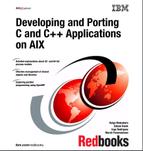Figures
| 1-1 | Core and orthogonal extensions | 15 |
| 2-1 | Object files and a library archive | 47 |
| 2-2 | Compiling and linking | 50 |
| 2-3 | An XCOFF format executable file and exec() | 63 |
| 2-4 | Static and shared text code in the executable file | 65 |
| 2-5 | The -bdynamic and -bstatic linker options | 66 |
| 2-6 | Function calling relationship | 78 |
| 2-7 | Function calling relationship after rebinding symbols | 81 |
| 2-8 | Function calling relationship for an interdependent shared object | 98 |
| 3-1 | Hardware, kernel, and user process relationships | 106 |
| 3-2 | Default memory model (segment usage) | 110 |
| 3-3 | Default memory model (detail) | 111 |
| 3-4 | Large memory model (segment usage) | 116 |
| 3-5 | Very large memory model (0 < maxdata < 0xB0000000) | 118 |
| 3-6 | Very large memory model (0xB0000000 =< maxdata < 0xD0000000) | 119 |
| 3-7 | Very large memory model (maxdata = 0) | 120 |
| 3-8 | Data and stack resource limits (default 32-bit process model) | 126 |
| 3-9 | The 64-bit memory model (1EB) | 131 |
| 3-10 | The 64-bit memory model (4 GB, the first 16 segments) | 132 |
| 3-11 | Shared memory segments between two processes | 143 |
| 5-1 | Process flow of a DLPAR operation | 211 |
| 6-1 | Structure padding in 32-bit mode | 237 |
| 6-2 | Structure padding in 64-bit mode | 238 |
| 6-3 | Structure with user-defined paddings in both 32-bit and 64-bit mode | 239 |
| 7-1 | Definition of HkWord | 269 |
| 8-1 | Two user threads in a process | 277 |
| 8-2 | Five Pthreads created by pthread_create() | 285 |
| 8-3 | Thread stacks (default 32-bit process model) | 293 |
| 8-4 | Thread models | 323 |
| 9-1 | Concept of barrier | 350 |
| 11-1 | Illustration of objects in fish.o and animals.o | 399 |
| 12-1 | Relationship among filesets, packages, and bundles | 406 |
| 12-2 | State diagram between applied and committed state | 410 |
| 12-3 | Relationship between APARs and update fileset | 411 |
| 12-4 | Sample .toc file | 413 |
| 12-5 | Directory structure for packaging | 419 |
..................Content has been hidden....................
You can't read the all page of ebook, please click here login for view all page.
